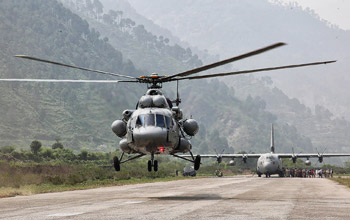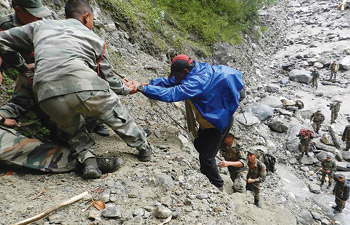INDIAN ARMED FORCES CHIEFS ON OUR RELENTLESS AND FOCUSED PUBLISHING EFFORTS

The insightful articles, inspiring narrations and analytical perspectives presented by the Editorial Team, establish an alluring connect with the reader. My compliments and best wishes to SP Guide Publications.

"Over the past 60 years, the growth of SP Guide Publications has mirrored the rising stature of Indian Navy. Its well-researched and informative magazines on Defence and Aerospace sector have served to shape an educated opinion of our military personnel, policy makers and the public alike. I wish SP's Publication team continued success, fair winds and following seas in all future endeavour!"

Since, its inception in 1964, SP Guide Publications has consistently demonstrated commitment to high-quality journalism in the aerospace and defence sectors, earning a well-deserved reputation as Asia's largest media house in this domain. I wish SP Guide Publications continued success in its pursuit of excellence.
- Appointments Committee of Cabinet approves one-month extension in service of Chief of the Army Staff
- Admiral Dinesh K. Tripathi assumes Command of the Indian Navy as 26th Chief of the Naval Staff
- Prime Minister witnesses 'Bharat Shakti' – a Tri-Services Firing and Manoeuvre Exercise in Pokhran, Rajasthan
- Interim Defence Budget 2024-25 — An Analysis
- Union Defence budget 2024
- Prime Minister Modi Commemorates Indian Navy Day in a Grand Ceremony
Largest rescue and relief operations by the Indian armed forces

It is considered as the one of the largest rescue operations of the Indian armed forces, evacuating civilians affected by the floods in Uttarakhand and Himachal Pradesh which has claimed thousands of lives.
The Indian Air Force launched ‘Operation Rahat’ while the Indian Army named ‘Operation Surya Hope’ to massive rescue and relief operations in the hill states of Uttarakhand and Himachal Pradesh where thousands of pilgrims have been stranded in difficult terrain and in hostile weather conditions.
Operation Rahat
Since June 17, the IAF has airlifted more than 20,000 people and dropping tonnes of relief material and equipment. On June 16, following flash floods due to heavy rains, the state governments sought assistance from the IAF. The Western Air Command (WAC) promptly responded to the requests and undertook simultaneous task in the sectors of Yamunagar, Kedarnath-Badrinath axis, Rudraprayag valley and the Karcham-Puh axis.
The Sarsawa Air Force Station was made the hub with helicopters convering from Bhatinda and Hindon. Several medium lift helicopters including the newly inducted Mil Mi-17 V5 were pressed into service. On June 19, the IAF deployed 20 aircraft including 8 Mi-17 helicopters, 10 advanced light helicopters (ALH), one An-32 transport aircraft and one HS-748 transport aircraft to carry out missions, covering Phata, Guptakashi, Gaurikund, Kedarnath in Dehradun and Rampur, Karcham, Reckong Peo, Sangla in Himachal. An IAF C-130J flew over flood affected areas in Dehradun–Uttarkashi, Kedarnath and Joshimath to identify critical areas in the region to help prioritise disaster relief operations and facilitate further rescue missions. Four ALH of the Sarang display team were also deployed for relief operations.
The IAF has its aircraft on standby at Ambala, Sarsawa, Bareilley, Gorakhpur and Agra for prompt missions towards providing continuous humanitarian aid to the flood-affected regions and is in constant touch with the district authorities for coordinating missions.
C-130J pressed into action
The first C-130J aircraft landed at Dharasu (a landing ground only 1,300 metres long) in the early morning today for the first time despite inclement weather. On landing the aircraft defuelled 8,000 litres of fuel into an empty bowser which was airlifted from Sarsawa by a Mi-26 helicopter. With the availability of additional fuel now at Dharasu, the extraction, evacuation and rescue operations have picked up pace and the available helicopters are now able to make more number of trips.
Apart from the carrying fuel to Dharasu, the first C-130J on its return trip carried about 40 and the second about 100 injured and stranded pilgrims to the safer plains of Air Force Station Hindon. An emergency medical centre has been set up at Air Force Station Hindon for the medical check-up of all the arriving tourists for immediate attention.
Assistance provided by the Army
Assistance provided by IAF
|
Having paved the way for fixed-wing aircraft landing at Dharasu, the IAF pressed it’s An-32 aircraft also into action. These aircraft are carried disaster communication equipment vehicle, some more aviation fuel, Sudan pumps for refuelling the helicopters and 4,200 kgs of bridging equipment of BRO. The heavy-lift Mi-26 helicopter will also be airlifting the heavy equipment of BRO to facilitate road repair and construction work.
While the fuel bridging has given impetus to rescue operations, increased flying activity in the narrow valleys is posing a new challenge to traffic management and safe flying. IAF has inducted additional personnel to ensure smooth planning, coordination and execution of flying operations, be it Air Force, Army or civilians.
Operation Surya Hope
The Indian Army put in place and commenced execution of ‘Operation Surya Hope’ with the aim of providing succor, hope, humanitarian assistance and logistic needs in Badrinath, Hemkund and Kedarnath regions. In first phase, Army teams carried out reconnaissance of area and air evacuation of isolated pockets along Govindghat-Badrinath road and Ghagriya-Hemkund track on June 19 and concentrate isolated people at Badrinath and Ghagriya by June 20.
In the second phase, Army focused on the Kedarnath region. After reconnaissance of the area, troops have concentrated relief efforts at Sonprayag and Kedarnath. In both Badrinath and Kedarnath sectors, Army inducted soldiers using helicopters and stationed them at every 2 km all along the roads to enable them to contact isolated people. Soldiers were providing leadership, succor, medical air and organising engineering efforts to clear road. Army inducted over 12 medical teams and opened emergency medical helpline. Besides it is providing stranded civilians’ access to Army communications to facilitate them to contact their families.
The Army so far inducted 5,600 personnel to carryout relief and rescue operations. About 15 Army helicopters have been pressed into service. At the time of writing this report, the Army so far evacuated 1,610 civilians in Uttarkashi district and provided shelter, food and medical aid to 1,300 people. In the Joshimath sector, 3,034 civilians have been evacuated to Joshimath so far and shelter, food and warm clothing have been provided to 1,276 people. In Kedarnath region, Army has been able to establish contact and distribute food packets to 250 people at isolated places. It had evacuated 1,550 people from Govindghat, inducted four more medical teams on Badrinath and Hemkund axis, distributed more than 5,000 food packets in Govindghat, Pandukeshwar, isolated locations in Badrinath and Kedarnath regions.
Lt General Anil Chait, Army Commander, Central Command, along with core team of officers are now located in the forward area of Uttarakhand to personally take stock of the situation, coordinate and ensure effective implementation of the plan with the sole aim of providing relief and rescue to stranded population.
ITBP at work
The Indo-Tibetan Border Police (ITBP) has evacuated all victims from Kedarnath Mandir area. However, victims from Rambada area are being evacuated on foot to Kedarnath area from where they are being airlifted. Teams of the National Disaster relief Force (NDRF) and ITBP is now searching for victims in nearby areas. ITBP airlifted 350 victims from Gaurigaon and 275 victims from Rambada. A major breakthrough came on Badrinath axis where more than 10,000 people are stranded. ITBP was able to make a rope bridge at, what used to be the Lambagad bridge over the river Alaknanda. One rescue party of the ITBP evacuated about 400 victims from Badrinath on foot, who were brought to Pandukeshwar.
Three battalions and personnel of Mountaineering & Skiing Institute are carrying out rescue and relief operations. These teams are well trained for mountain rescue. They are acclimatised and equipped with specialised equipments used for relief and rescue work at high altitude mountainous areas. These teams are trained for such types of relief and rescue work as ITBP does most of the search and rescue work in high Himalayas.
BRO working overtime
The Border Roads Organisation was working overtime having deployed over 3,000 of its personnel and various equipment to clear roads. It has diverted its resources, personnel and equipment for projects such as Shivalik, Deepak and Hirak for clearing roads and to rescue the affected people. All bulldozers, JCBs, excavators, compressors and other platforms have been deployed for the rescue and restoration work.






